Abstract
According to an evaluation by EU experts, the Finnish education system has long had characteristics that make it one of the best systems in Europe. In the context of music education, it is an inspirational resource suitable for optimisation of music education in the Czech Republic, which is especially needed at primary schools. The starting point for comparison of the Finnish and Czech music education of pupils is the set of national curricular documents for primary education in both countries and observation of music instruction at the Polorahti Primary School in Helsinki. Based on observation, and analysis of video recordings from music instruction, music-related movement activities were selected, which became the subject of the second part of the research. The music-related movement activities implemented in Finnish music education were realised in 24 classes at three primary schools and at three art primary schools in the Czech Republic. In the subsequent questionnaire, the addressed pupils answered questions relating to experience with the particular activities, their attractiveness and their difficulty. Teachers were asked about the benefits of activities for music instruction. The pupils evaluated music activities as very attractive and atypical, and the teachers evaluated them as inspiring and effective for the development of pupils’ musical skills.
Keywords: Music educationprimary schoolFinlandCzech Republic
Introduction
As in other European countries, a review of the education system is taking place at the moment in the Czech Republic. The current way of learning is being analysed; prognostic factors are being created; and education systems from abroad are being studied and evaluated. Inspiration is being sought particularly in countries that have long achieved excellence in international educational indicators. According to the evaluation from EU experts, the Finnish educational system has some of the best characteristics in Europe (Průcha, 2017). In the context of music education, it is an inspirational resource suitable for optimisation of music education in the Czech Republic, which is especially needed at primary schools.
Problem Statement
In Finland and in the Czech Republic, binding frameworks for education at primary schools is defined in curricular documents at the state and school levels. The Finnish National Curriculum for Primary Education fulfils in the Czech Republic the Framework Educational programme for Basic Education (FEP BE). The parallel to documents under which instruction occurs at individual schools is represented by the municipal curriculum in Finland and the Czech school education programmes (SEPs). The definition of the subject of music education in state documents in terms of duration of education, hourly subsidy, the content of the school curriculum and the expected outputs per pupil during music education were almost identical. Both subjects have very similarly formulated education objectives. The priority is to help create a school pupil's relationship to music, encourage them to actively engage in music activities, to create the conditions to their own music creativity and to support their overall personality growth. Since the definition of music education differs to a minimum extent in national curricular documents, the difference in quality of music education at Czech and Finnish primary schools cannot be attributed to official documents, but rather to teaching methods, motivation of pupils, conditions for music education and the competence of instructors.
Research Questions
Are there any non-traditional and innovative methods in Finnish music-instruction which can be effectively applied in music education at Czech primary schools?
Purpose of the Study
The aim of the study is to implement the basic differences in music instruction of pupils at elementary schools in Finland and in the Czech Republic, to describe non-traditional methods of current Finnish music-education and to evaluate the options for their application in Czech education of pupils at primary schools.
Research Methods
Within the first part of the research, a comparison was done between curricular documents for primary education in Finland and the Czech Republic. Observation was also done of music education at the Polorahti Primary School in Helsinki, and its main aim was to observe the following during the music instruction hours:
The teaching environment
The communication climate in class
The hourly subsidy for the subject, the time structure of each instruction hour
The curriculum
Methods and organisational forms of instruction
Evaluation
An analysis was then conducted of video recordings and record files from instruction hours, and music-related movement activities were selected, which became a basis for the second part of the research.
The second part of the research was carried out on the basis of the implementation of music-related movement activities applied in Finnish music-education and on the basis of a subsequent questionnaire survey in 24 classrooms of three primary schools and three art primary schools in the Czech Republic. The activities were selected for individual classes in view of the number of pupils, the ages of the pupils and the spatial options allowed by the classrooms. In a single instruction hour, three to four activities were carried out. In the questionnaire, the addressed pupils (a total of 335) first answered the question of whether they were familiar with the activities. Then, for individual activities, they were supposed to express in a number of points on a scale of 1 to 5 how attractive the activities were and their levels of difficulty. The addressed teachers (a total of 12) were first asked to specify how often they focused on the development of pupils’ rhythmic feelings during their instruction hours. Then, on a point scale of 1 to 5, they were supposed to evaluate the importance of the activities from the perspective of development of rhythmic feelings, their movement coordination and social interaction among pupils. On a point scale of 1 to 7, the teachers were supposed to evaluate the level of pupils’ activity and their emotional experience. Finally, teachers were asked to state to what extent the activities had been inspiring for them. The teachers had the option of adding their own free comments to the evaluation using the scaling method. The results of the questionnaire were quantified and briefly commented.
Findings
Observation of music instruction at the Polorahti Primary School in Helsinki
Category No. 1: Teaching environment
During the music lessons, the pupils showed, besides the influence of external motivational factors for learning, also, their own very strong internal motivation for education. The pupils were curious, accepted tasks from the teacher without negative reactions, tried to work separately and independently, and when successful, they clearly expressed their joy and a feeling of pride. The expressions of failure in pupils’ hours were basically not observable. The strong motivation of pupils for learning was certainly one of the outcomes of the significantly positive classroom environment, which the pupils and the teacher managed to form regardless of school year levels in all instruction hours. The apparent social integration and democratic style of the teacher’s approach to the pupils was balanced by plenty of control shown by her along with solid educational effect. The teacher provided her pupils with opportunities to show initiative, independence and creativity in their work and in interpersonal relations. Everyone respected one another, communicated and shared feelings and opinions openly and clearly. The pupils addressed the teacher by her first name and used the familiar verb form.
The music instruction hours took place in a professional classroom, which satisfied all of the requirements for music education with regard to space, equipment and sanitary requirements. In the front section, there was a board with a note curriculum, a projection screen, a digital piano, a teacher’s desk with a reverse projector, guitars and a DVD player with a set of speakers. The middle of the class was filled with twelve benches with keyboards. In the rear section of the classroom, there was free space intended for music-related movement activities, and another four small tables with computers, keyboards and speakers. From the pupils’ view on the right, along the entire wall there was a set of cabinets, which served as an archive for CDs, textbooks, rhythmic and melodic easily usable musical instruments, posters, maps, pictures, headphones and teaching aids. Teaching aids, instruction material and various sources of inspiration were incomparably richer, more refined and more sophisticated than those available to the Czech teachers.
Compared to the traditional environment of Czech schools, the operating rules of the classroom and the organisation of breaks differed. Pupils from the 1st to 3rd years came to class without any supplies, and they did not bring either bags or outdoor clothing, and they changed their shoes. For pupils of the 4th to 6th year, the same rules applied for entering the classroom, but unlike their younger classmates, they brought with them writing supplies, a notebook and their own musical instruments, such as fiddles, accordions, flutes. There was a strict ban on food consumption in the classroom, which was based on the school regulations. After the hour ended, the pupils always carefully cleaned up afterwards, and without being asked to do so, they returned chairs and learning aids to their places without hesitation. For certain breaks defined by school rules, the pupils walked to spacious play areas, which were part of the park next to the school. They spent breaks outside even during slightly unfavourable weather. During the period between class hours, the teacher was careful to ensure that the classroom was intensively
Front section of classroom ventilated and usually the windows remained open for the duration of break time.
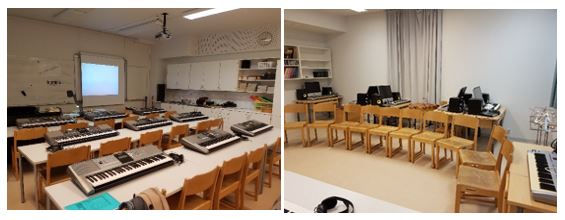
Category No. 2: Communication
The dominant figure during instruction was clearly the teacher. Her overall demeanour was calm, but not monotonous. She had a clear and stylish tone of voice, and for ensuring calm and the necessary atmosphere in the classroom, she worked with its dynamics and with tone height. She formulated instructions clearly, and often very concisely. For example, saying so – la meant for students the need form pairs, in which one assumed the role of so and the other la.
In view of the significantly active style of teaching, the teacher seldom wrote on the board. Her writing was legible and well structured, and it even included emoticons. The teacher emphasised important information by drawing rectangles around words.
It was interesting to see this form of non-verbal communication between the teacher and pupils, which is atypical for the Czech environment. Whenever the noise level increased in the classroom, the teacher or any of the pupils could raise their thumb above their head and give the others in the room the signal: “I am quiet, be with me!” If someone needed to go to the toilet, they raised their hand over their head with two extended fingers, and a hand with an open palm above the head meant: “I want to say something.” The teacher also used gestures for illustration of tones and the direction of the melody during relative singing of notes. As far as vision is concerned, she maintained natural direct eye contact with the pupils. In order to facilitate discipline among pupils, she used focused views of specific pupils at times. This method of visual communication and a gesture using an extended thumb were usually enough to ensure calm in the classroom, and additional verbal reminders were not necessary. The teacher used increased mimicking to instruct the pupils to begin singing, when she played the piano or directed. A warm smile was an expression of her positive emotional experiences during instruction. The teacher’s movement activity in the classroom was reasonable, and during instruction she mainly stood. Of the four types of communication distance depending on activities, she mostly maintained personal and interactive distance and public space. Whenever it was necessary to correct how a pupil gripped or used an instrument, she significantly interfered with the pupil’s personal space and sometimes even touched the pupil.
From the point of view of communication via activities, it is necessary to emphasise the importance of the teacher and pupils greeting each other at the start and conclusion of the instruction hour and to inform parents if a pupil has not brought in homework or has not arrived for a lesson with the required supplies.
During instruction, the pupils had plenty of room for communication. They mainly communicated with the teacher while seated. Their expression was calm, and they did not raise their voices. When problems needed to be solved they asked the teacher and their classmates for help. The pupils took notes in their paper notebooks as of the 4th year, and they mostly used ordinary pencils.
Category No. 3: The hourly subsidy for the subject, the time structure of each instruction hour
According to the teaching plan, curriculum of Polorahti Primary School in the 2017/2018 school year, music instruction in individual years of study had the following hourly grants.
Each music education hour lasted 45 minutes, and the hours did not have a regular structure.
In the 1st to 3rd years of study, the hours mainly had an interactive character and were conducted in these phases:
Joint musical greeting between teachers and pupils (1 minute)
Motivation (familiarisation of pupils with the contents and objective of the lesson hour) (2 minutes)
Music-related movement games (10–15 minutes)
Intonation, review of already mastered song repertoire, practice of new songs (20–25 minutes)
Summarisation, evaluation of the course of the instruction hour (2 minutes)
Joint musical expression of parting between teachers and pupils (1 minute)
In the 4th to 6th years, the structure of observed lesson hours was not as regular as in lower years. The reason was that a greater number of organisational forms and teaching methods was used. However, most instruction hours occurred in these phases:
Joint musical greeting between teachers and pupils (1 minute)
Administrative part of the lesson hour (taking of attendance) (1 minute)
Motivation (familiarisation of pupils with the contents and objective of the lesson hour) (2 minutes)
Review of music theory topics (5 minutes)
Interpretation of new music theory topics (5–10 minutes)
Practice of learning topics (5–10 minutes)
Music-related movement games (5–10 minutes)
Review of already mastered song repertoire (5–10 minutes)
Summarisation, evaluation of the course of the lesson hour (1 minute)
Joint musical expression of parting between teachers and pupils (1 minute)
Category No. 4: The curriculum
The curriculum that was the subject of music instruction was selected by the teacher in accordance with the requirements of the
The following overview describes the learning topics and activities that were the subject of instruction:
vocal activities: The repertoire of single-voice and multi-voice folk and artistic Finnish and Swedish songs, adoption of a proper means of breathing, pronunciation, deployment and formation of tone, orientation in the note scale of a song - prima volta, seconda volta, repetition, diatonic approaches in major and minor tones via note scaling; music-related movement activities: movement expression of music and reaction to changes in the flow of music - pantomiming and stylistic walking, creation of movement memory; listening activities: verbal expression (what kind of music is it, and why it is such), basic properties of tones; instrumental activities: blues improvisation (12 bars), creation of song accompaniment, pre-play and play in between sessions; music theory: major and parallel minor scales up to two crosses, quintal chords; music styles and genres: characteristic properties of blues
Category No. 5: Methods and organisational forms of instruction
-
Organisational forms
Music teaching took place across all years of instruction in classes split in half containing 11-14 pupils. The low number of pupils, which is far below the average number of pupils in regular classrooms in the Czech Republic and Finland, contributed significantly to the effectiveness of music instruction.
According to the categorisation of the system of organisational forms of instruction of Lászlo and Škvarková (2009), the teacher applied in organisational forms of instruction in relation to a pupil 68% of a team method of instruction, and she used 19% of a group form, and 13% of instruction was given in an individualised form. In one case, parallel groups for instruction of the same topic were merged for a lesson hour, which is atypical in the Czech school environment. With regard to organisational forms in relation to the character of the environment, instruction took place in the aforementioned professional classroom.. The education of pupils included mandatory homework.
Teaching methods
During instruction, the teacher selected targeted and well planned teaching methods, which supported music discovery and the thinking process of pupils, and through music activities, they developed their musical skills (especially musical imagination and recall) and knowledge and gave the students new musical insight. The teacher used methods that enabled her to distinguish between the collective of pupils and an individual approach to pupils and which encouraged musical activity among pupils. The level of pupils’ music activities is also a criterion of Sedlák's categorisation of teaching methods (Sedlák, 1984, p. 108). Based on how the teaching method encourages and ensures the level of pupils’ activity, three groups can be identified. The first involves
The second group of Sedlák's categorisation consists of
The third group of Sedlák's categorisation includes
Category No. 6: Evaluation of pupils
The teacher evaluated pupils continuously. She selected the forms of evaluation based on the pupils’ ages. In the 1st to 5th years of study, she mainly used verbal comments. In written form with a grade of either pass or fail, she evaluated tests of music theory. The teacher commented regarding the momentary performance of pupils, and based on comparison of video recordings from various periods, she also assessed their progress. Although this form of evaluation brings students important feedback, for Czech teachers it is atypical. During instruction, the teacher also praised the pupils, but she also encouraged them to give self-evaluations. For pupils in the 6th year of study, she used verbal evaluations based on a seven-point scale (the best grade on the scale was 10 and the worst was 4). The teacher informed the parents about the education of the pupils, including their evaluation, via the Wilma electronic system.
Music-related movement activities
As has already been stated on page 10, one of the dominant parts of instruction was music-related movement activity. In view of the shortage of teaching aids and other inspirational source in music-related movement education in the Czech music teaching environment, music-related movement activities engaged in during music instruction hours at the Polorahti Primary School became the starting point for the second part of the research.
In view of the character and scope of the Article, only two activities are specified in the text as examples.
Activity No. 1
Pupils stand in a circle, with the teacher in the middle.
The pupils try out which sounds they can produce with their own bodies. They clap for a while, they poke around, clap their thighs, kiss, whisper, whistle, etc.
The teacher stands before a random pupil in the circle and demonstrates a body game with a random two-stroke rhythmic figure in 4/4 beat. The pupil imitates the figure. The teacher helps the pupil until the pupil is able to repeat the figure perfectly on their own.
The teacher moves to another pupil in the circle and demonstrates a different one, again a two-stroke rhythmic figure in 4/4 beat. The teacher helps the pupil until the pupil is able to reproduce the figure alone.
The teacher gradually switches to additional pupils in the circle, creating a rhythmic chorus.
Activity No. 7
The pupils stand in a semi-circle, with the teacher in front of them.
The teacher improvises for the 1st (do), 2nd (re), 3rd (mi) and 5th (so) note scale and creates a two-stroke melodic-rhythmic figure in 4/4 beat. Singing of notes on the scale is accompanied by phonogestics connected with relative solmisation as defined by Zoltan Kodaly. The pupils imitate the melodic-rhythmic figures after the teacher.
The teacher selects a pupil, who sings a random tone, and this sets the 1st level of the transposed musical scale. That pupil creates their own two-stroke melodic-rhythmic figure in a new tone, and the others imitate.
The pupils sing the following four-strokes for the syllable na, for solmisation syllables, for names of tones in the particular scale or their own text. The heights of the tones are determined by numerals in the written notes. The sung melody is accompanied by described phonogestics (see reference 38).

-
The pupils sing the specified melody as a canon. The second voice follows one beat after the first voice.
6.2. Questionnaire survey
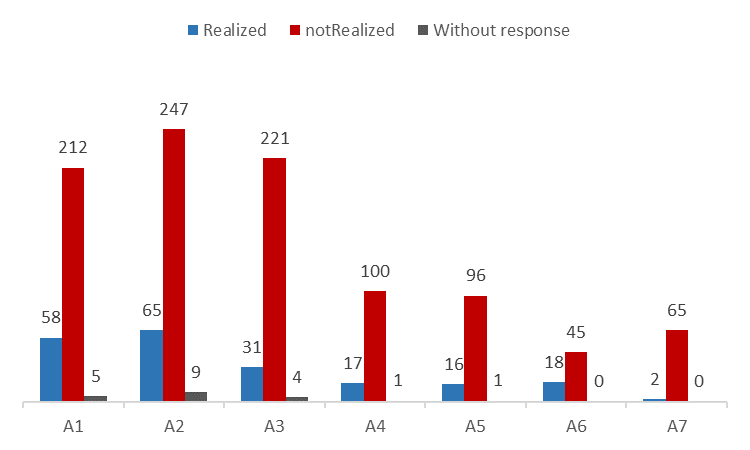
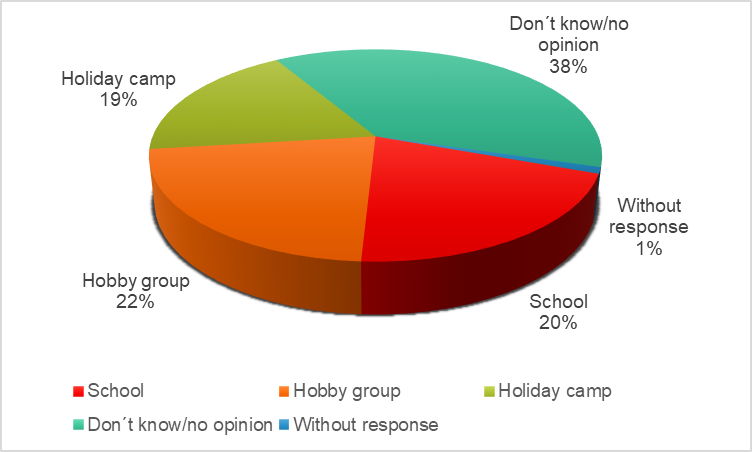
The results of Graph No. 1 show that the overwhelming majority of pupils who have taken part in the research engaged in music-related movement activities A1 – A7 for the first time ever. The least familiar to them was Activity No. 7, with which only 3% of surveyed pupils were already familiar. The most familiar to them was Activity No. 6, with which 28,6% of surveyed pupils were already familiar. If pupils completing the questionnaire stated that an activity was familiar to them, then, they also answered the question about where and how they had become familiar with the activity. It is apparent from Graph No. 2 that in 38% of the responses, the pupils were unable to specify a specific environment in which they became familiar with the activity, and in 22% of responses, they said they had learnt the activity from an extra-curricular group, and 20% said they had learnt it in school. However, only 3,5% of the questioned pupils said this out of the total number of all responses. Since none of the teachers who participated in the research study was unfamiliar with the activities, the pupils must have encountered the particular activities (or similar ones) in another teacher’s class. The degree of similarity between activities was not further addressed.
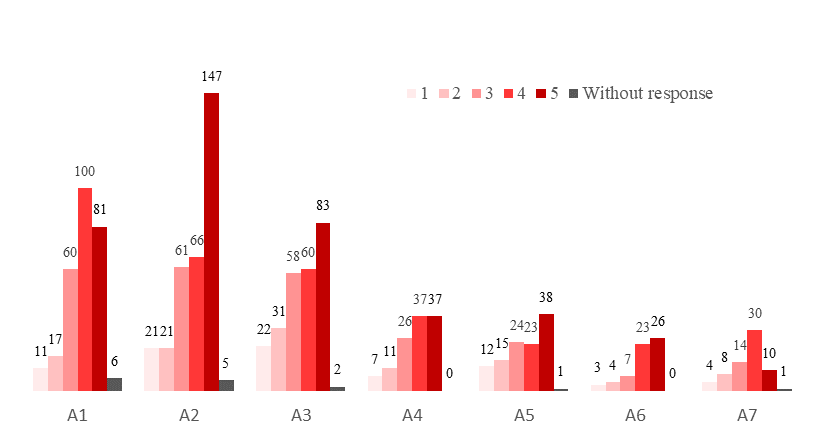
Graph No. 3 describes the attractiveness of individual activities for pupils. On a point scale of 1–5, the value 1 expresses the least degree of attractiveness, while the value of 5 expresses the greatest. It is apparent from the graphic illustration that the pupils evaluated the activities positively. This is also proved by mean point values (arithmetic averages) calculated for individual activities: A1 –
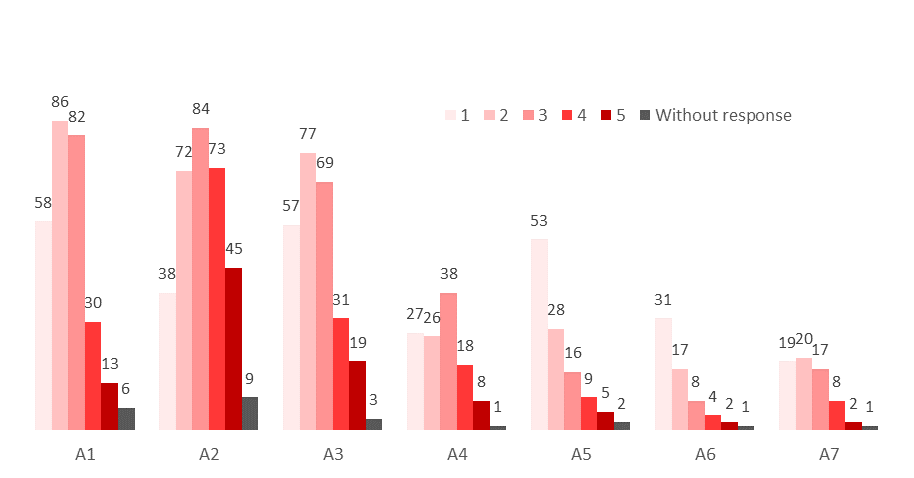
Graph No. 4 describes the levels of difficulty of the individual activities for pupils. On a point scale of 1–5, the value 1 the expresses the least difficulty, and the value 5 expresses the greatest. It is apparent that the individual activities seemed rather easy to the pupils. This is also demonstrated by the following calculated arithmetic averages: A1 –
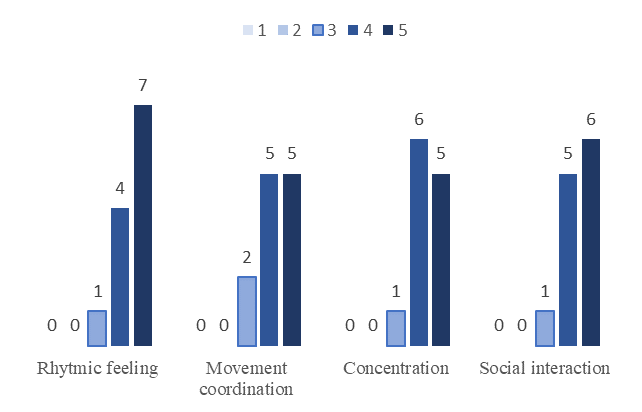
Graph No. 5 expresses the evaluation of realised activities from the perspective of the present educators. The evaluation is focused on the contribution of individual activities from the point of view of development for rhythmic feeling movement coordination, the level of concentration and social interaction of pupils. On a point scale of 1–5, the value 1 expresses the least benefit for the development of the pupil, while the value of 5 expresses the greatest. It is apparent from the graph that the teachers evaluated the activities overall as very beneficial, which is also demonstrated by the expressed arithmetic averages: RF –
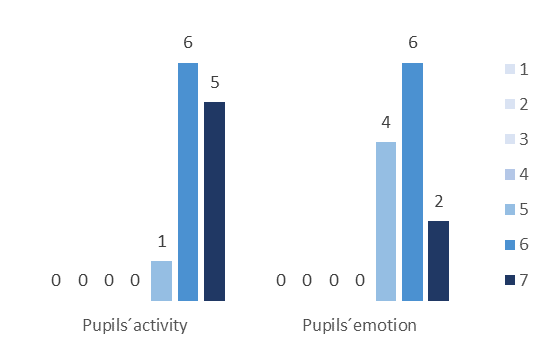
Graph No. 6 describes how the teachers evaluated the level of activity and emotional experience of their pupils. The evaluation scale is divided into seven points, with the value 1 being the lowest level and the value of the 7 degree being the highest. It is clear from the graph that teachers evaluated the pupils as very active (PA –
It is also apparent from the questionnaire research that seven Czech educators use within the scope of their instruction activities to develop the rhythmic feeling of pupils occasionally, and five do so in every instruction hour. Eight surveyed educators evaluated the presented activities as very inspiring, while four said they were partly inspiring. In free comments, the teachers evaluated the activities positively, but some of them said they considered them demanding due to time constraints and spatial organisation.
Conclusion
The comparison of the Czech and Finnish music education of pupils has confirmed that the situation in the school education system is a reflection of the whole society. The Finnish school system emphasises for children at an early age the importance of their awareness of national identity and cooperation with others. This leads to a responsible approach to their own education, which is also one of the explanations for the very strong internal motivation of pupils to learn. The values preferred by Finnish society and by the Finnish education system are reflected in the positive attitude of children about their school and their perception of education in general.
The method used to evaluate them is also an important part of pupils’ education. While, in the Czech environment, a grade is often the sole and/or primary indicator of a pupil’s performance, the Finnish evaluation method helps with general growth and development of a pupil’s personality.
The comparison of both national education curricula has shown how they are related. The objectives of music education are the same, but the content of curricula differs in particular in processing of music-related theoretical findings in FEP BE. No fundamental differences were found either in the methodical approaches used during instruction, with the exception of the solmisation method. Certain differences can be identified in the preferences of musical activities, in the degree of the individual approach to pupils and in the quality of textbooks and methodical materials for teachers. The unsuitable methodology system is known to many Czech teachers, who are trying to change the situation by creating their own education materials and aids. However, their activity is entirely individual and is often neither systematic nor coordinated. A shortage of quality-inspiring sources for music instruction has also been reflected in the findings from research conducted at Czech primary schools. The teachers were unfamiliar with the demonstrated music-related movement activities, and they considered them a good idea and something effective for music instruction.
One of the additional causes of the differences between the levels of musical output of pupils is the quality of teacher training, their levels of competence, their positions in society, and, last but not least, also, their financial rewarding. A major problem in the Czech education system increasingly has been a shortage of fully qualified teachers and not enough availability of future music instructors.
The direction of Czech music education historically has had certain excellent conditions for successful and modern education. The level of future Czech music education therefore will depend on motivation, quality life-long learning and the professionalism of teachers. Without support from the state and without a value foundation in society as a whole, however, these objectives will be difficult to achieve.
Acknowledgments
The article was written on the basis of the Specific Research of Faculty of Education of University Hradec Králové, with the title Application of Current Trends in Finnish Music Education within Czech Music Education.
References
- Bělohlávková, V. (2001). Jak porozumět řeči těla: pro ty, kteří chtějí přesvědčit protější stranu [How to Understand Body Language: For Those Who Want to Convince the Opposite Side]. Brno: Computer Press.
- ePerusteet. (2014). Perusopetuksen opetussuunnitelman perusteet 2014. [online]. [cit. 2018-23-07]. Retrieved from: https://eperusteet.opintopolku.fi/#/fi/perusopetus/419550/sisallot/466343?valittu=42870
- Finnish National Board of Education. (2014). Basic Education. [online]. [cit. 2018-23-07]. Retrieved from: http://www.oph.fi/english/curricula_and_qualifications/basic_education
- Finnish National Board of Education. (2016). Curriculum reform 2016. [online]. [cit. 2018-23-07]. Retrieved from: http://www.oph.fi/english/education_development/current_reforms/curriculum_reform_20 16
- Fontana, D. (2014). Psychologie ve školní praxi: příručka pro učitele [Psychology in School Practice: Teacher's Guide]. Prague: Portál.
- Jenčková, E. (2005). Hudba a pohyb ve škole [Music and Movement at School]. Hradec Králové: Tandem.
- Kotrba, T. Lacina, L. (2015). Aktivizační metody ve výuce: příručka moderního pedagoga [Activation Methods in Teaching: Modern Teacher´s Guide]. Brno: Barrister & Principal.
- László, K. Škvarková, Z. (2009). Didaktika [Didactics]. Banská Bystrica: University of Matej Bel.
- Ministerstvo školství, mládeže a tělovýchovy. (2017). Rámcový vzdělávací program pro základní vzdělávání. [online]. Prague: MŠMT, 165. [cit. 2018-28-07]. Retrieved from: http://www.nuv.cz/uploads/RVP_ZV_2017.pdf
- Organisation for Economic Co-operation and Development. (2017). Education at a Glance 2017, OECD Indicators. [online]. OECD, 456. [cit. 2018-23-07]. Retrieved from:
- http://www.oecd.org/education/education-at-a-glance-19991487.htm
- Průcha, J. (2013). Moderní pedagogika [Modern pedagogy]. Prague: Portál.
- Průcha, J. (2017). Vzdělávací systémy v zahraničí: Encyklopedický přehled školství v 30 zemích Evropy, v Japonsku, Kanadě, USA [Educational Systems Abroad: Encyclopaedia of Education in 30 Countries of Europe, Japan, Canada, USA]. Prague: Wolters Kluwer.
- Průcha, J. Kansanen, P. (2015). Školní vzdělávání ve Finsku [School Education in Finland]. Prague: Charles University in Prague, Karolinum.
- Sedlák, F. (1989). Psychologie hudebních schopností a dovedností [Psychology of musical abilities and skills]. Comenium Musicum 20. Prague: Editio Supraphon.
- Sedlák, F. et al. (1984). Didaktika hudební výchovy 2: Na druhém stupni základní školy [Didactics of Music Education 2: Lower secondary education]. Prague: SPN.
- Sedlák, F. Váňová, H. (2016). Hudební psychologie pro učitele [Musical Psychology for Teachers]. Prague: Charles University in Prague, Karolinum.
Copyright information

This work is licensed under a Creative Commons Attribution-NonCommercial-NoDerivatives 4.0 International License.
About this article
Publication Date
14 January 2019
Article Doi
eBook ISBN
978-1-80296-052-5
Publisher
Future Academy
Volume
53
Print ISBN (optional)
-
Edition Number
1st Edition
Pages
1-812
Subjects
Education, educational psychology, counselling psychology
Cite this article as:
Kováříčková, M. (2019). Application Of Current Trends In Finnish Music Education Within Czech Music Education. In Z. Bekirogullari, M. Y. Minas, & R. X. Thambusamy (Eds.), ICEEPSY 2018: Education and Educational Psychology, vol 53. European Proceedings of Social and Behavioural Sciences (pp. 717-732). Future Academy. https://doi.org/10.15405/epsbs.2019.01.70

